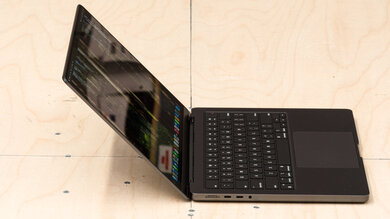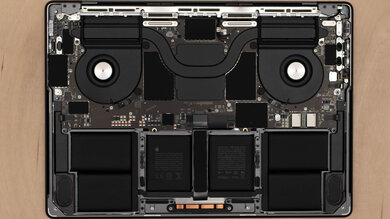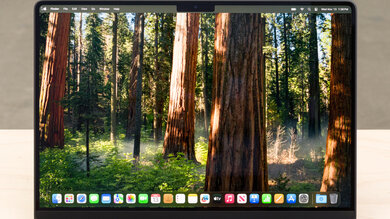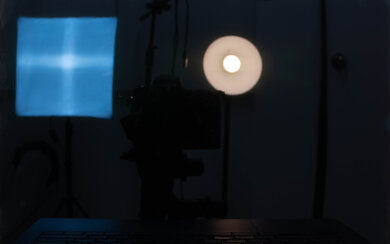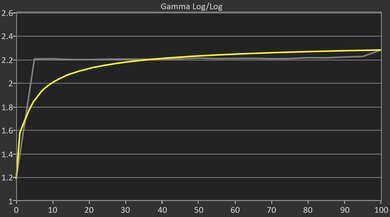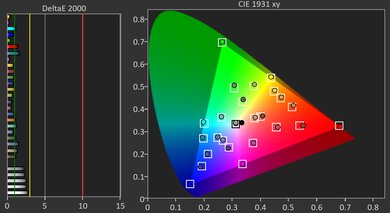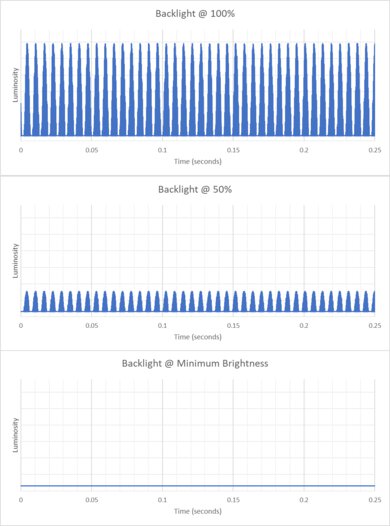The Apple MacBook Pro 14 (2024) is a premium workstation laptop. It replaces the Apple MacBook Pro 14 (M3, 2023). This 2024 model is configurable with an M4, M4 Pro, or M4 Max SoC, up to 128GB of RAM, and up to 8TB of storage. It has a 120Hz Mini LED Liquid Retina XDR display, which, unlike previous MacBook Pros, is now available with a glossy or nano-texture finish. Also new on this M4 model is a 12 MP camera with Center Stage support. Ports include three USB-C/Thunderbolt 5s (Thunderbolt 4 on base M4 model), an HDMI 2.1, a full-size SD card reader, a headphone jack, and a MagSafe charging port. There's no longer a Space Gray color—only Silver and Space Black.
See our unit's specifications and the available configuration options in the Difference Between Variants section.

If you're looking to pick up a new laptop on Black Friday, check out all the best deals that we've found this year!
Our Verdict
The Apple MacBook Pro M4 is excellent for general productivity. It's an incredibly well-built laptop that's easy to carry, and its battery lasts over 15 hours of light use, perfect for those who travel a lot. It has a sharp display, a large, easy-to-use haptic touchpad, an excellent webcam, and tons of ports. You also get a fingerprint sensor, so you can log in quickly and avoid typing in your password in public spaces. The keyboard feels spacious and tactile, but heavy typers may not like it, as its short key travel can cause fatigue. Performance is superb; this laptop can easily handle general productivity tasks like text processing, but is also ideal for editing photos and videos. Unfortunately, none of the components are user-replaceable, and there's no USB-A port, so you'll need an adapter for your wired peripherals or dongles.
Exceptional build quality and compact design.
All-day battery life.
Provides amazing user experience with its bright display, tactile keyboard, and large haptic touchpad.
Wide port selection.
Outstanding 1080p webcam with Center Stage support.
Soldered RAM and storage.
Heavy typers may not like the keyboard's short travel.
The Apple MacBook Pro M4 is outstanding for media consumption. It's very portable, and its battery lasts over 13 hours of video playback, giving you plenty of time to get through multiple full-length movies and TV show episodes. The display looks incredibly sharp, colorful, and well-calibrated, and it gets bright enough for use in most settings, even outdoors in broad daylight. It can produce deep blacks, but because its Mini LED backlight doesn't have pixel-level control like OLED panels, you'll see some blooming around bright objects in dark scenes. The speakers sound well-balanced and full, with a good amount of bass, and they get very loud with minimal artifacts at max volume.
Exceptional build quality and compact design.
All-day battery life.
Sharp, colorful, Mini LED display.
Loud speakers sound natural and clear, with a good amount of bass.
No touch input support.
Some blooming around bright objects in dark scenes.
While the Apple MacBook Pro M4 has the processing power to run demanding games, it still isn't ideal for gaming. This is because many games don't run on macOS, and only a handful of those that have macOS support run natively on Apple silicon, meaning performance will vary a lot depending on the game. Additionally, while its Mini LED display's 120Hz refresh rate gives smoother motion and increased input responsiveness, its response time is on the slow side, causing noticeable ghosting in fast-moving scenes. On the upside, it has a fast SSD to help shorten loading times, and it doesn't get overly hot or loud under load.
CPU and GPU can handle demanding tasks.
120Hz display.
Minimal throttling under load.
Doesn't get overly hot or loud.
Soldered RAM and storage.
Heavy typers may not like the keyboard's short travel.
Limited number of games with macOS support.
Performance varies, as many games lack optimization for Apple silicon.
The Apple MacBook Pro M4 is a great workstation laptop. It can handle nearly every type of workload, including demanding tasks like video editing, 3D graphics, AI development, and scientific simulations. You can also do all of your color-sensitive work on the built-in display, as it has full coverage of the DCI-P3 color space and superb factory calibration. There's a wide port selection for peripherals and external monitors, including three USB-C/Thunderbolt 5s and an HDMI 2.1. Thermal throttling is minimal under load, and the laptop doesn't get overly hot or loud. Unfortunately, none of the components are user-replaceable, so you need to get the configuration that best suits your needs upfront.
CPU and GPU can handle demanding tasks.
Wide port selection.
Display is suitable for content creation and other color-critical work.
Minimal throttling under load.
Doesn't get overly hot or loud.
Soldered RAM and storage.
Heavy typers may not like the keyboard's short travel.
Changelog
-
Updated Nov 27, 2025:
Added mention of the Apple MacBook Pro 14 (M5, 2025) as an alternative to the base model in the CPU section.
-
Updated Nov 17, 2025:
We've retested the Geekbench 6 - GPU Compute benchmark to re-validate the score. The result remains in the same ballpark as our original measurement, raising only slightly from 98,654 to 101,346.
-
Updated Oct 30, 2025:
We've updated text throughout the review after converting to Test Bench 0.9.
- Updated Oct 30, 2025: We've updated the review to Test Bench 0.9, which adds several test boxes in the performance section, including CPU/RAM Performance, Low Tier Graphics, High Tier Graphics, Professional 3D (GPU accelerated), CPU-Intensive Game Performance, GPU-Intensive Game Performance, and Ray Tracing Performance. See the 0.9 changelog here.
Check Price
Differences Between Sizes And Variants
We tested the Apple MacBook Pro 14 with a standard glossy display, a base M4 Pro SoC (12-core CPU and 16-core GPU), 24GB of RAM, and 512GB of storage. The display, SoC, RAM, and storage are configurable; see the table below for all available configuration options.
Note: We've also purchased a second unit with a nano-texture display, a base M4 SoC (10-core CPU and 10-core GPU), 16GB of RAM, and 1TB of storage to test the nano-texture display. You can see more information in the display and performance sections of the review.
SCREEN
- 14.2" Mini LED 3024 x 1964 120Hz (Standard Glossy Liquid Retina XDR display with ProMotion)
- 14.2" Mini LED 3024 x 1964 120Hz (Nano-Texture Liquid Retina XDR display with ProMotion)
SoC
- M4 10-core CPU, 10-core GPU, 120GB/s memory bandwidth
- M4 Pro 12-core CPU, 16-core GPU, 273GB/s memory bandwidth
- M4 Pro 14-core CPU, 20-core GPU, 273GB/s memory bandwidth
- M4 Max 14-core CPU, 32-core GPU, 410GB/s memory bandwidth
- M4 Max 16-core CPU, 40-core GPU, 546GB/s memory bandwidth
Memory
- 16GB LP-DDR5x 8533MHz (M4 only)
- 24GB LP-DDR5x 8533MHz (M4 or M4 Pro)
- 32GB LP-DDR5x 8533MHz (M4 only)
- 36GB LP-DDR5x 8533MHz (M4 Max with 32-core GPU)
- 48GB LP-DDR5x 8533MHz (M4 Pro or M4 Max with 40-core GPU)
- 64GB LP-DDR5x 8533MHz (M4 Max with 40-core GPU)
- 128GB LP-DDR5x 8533MHz (M4 Max with 40-core GPU)
STORAGE
- 512GB PCIe Gen 4 NVMe SSD (M4 and M4 Pro)
- 1TB PCIe Gen 4 NVMe SSD
- 2TB PCIe Gen 4 NVMe SSD
- 4TB PCIe Gen 4 NVMe SSD (M4 Pro or Max)
- 8TB PCIe Gen 4 NVMe SSD (M4 Max)
COLOR
- Silver
- Space Black
See our unit's label.
Popular Laptop Comparisons
The Apple MacBook Pro M4 is one of the best laptops on the market. Its performance is industry-leading compared to other current-gen laptops, and it also delivers a fantastic user experience, thanks to its gorgeous Mini LED display, large haptic touchpad, full-sounding speakers, and high-quality webcam. Its build quality is second to none, and its battery life is also among the best you can find on such a powerful device. That said, it isn't as versatile as Windows devices, as the lack of macOS games and titles optimized for Apple silicon makes it less ideal for gaming.
For more options, check out our recommendations for the best workstation laptops, the best video editing laptops, and the best laptops for music production.
The Apple MacBook Air 15 (M4, 2025) and the Apple MacBook Pro 14 (M4, 2024) are very different offerings. Get the Air if you want a sleek ultraportable that's ideal for general productivity tasks, and get the Pro if you need a mobile workstation fit for resource-intensive tasks like 3D rendering or simulation work. The specifications vary accordingly; the Air uses the base M4 SoC and is available with up to 32GB of RAM and 2TB of storage, while the Pro is configurable with either the base, Pro, or Max M4, and up to 128GB of RAM and 8TB of storage. The Pro also comes with a much brighter Mini LED display with a 120Hz refresh rate. Both laptops are exceptionally well-built and provide excellent user experiences: spacious keyboards, responsive haptic touchpads, and class-leading speakers.
While the Apple MacBook Pro 14 (M4, 2024) is a much better device than the Apple MacBook Air 13 (M4, 2025), they aren't intended for the same audience. The Air is an ultraportable designed for light to moderately intensive workloads, while the Pro is a much more powerful device aimed at professionals, like content creators. The Pro has a nicer Mini LED display, more ports, and longer battery life. If you want the niceties of the Pro model but don't need the extra processing power, know that the Pro is also available with the base M4 SoC.
The Apple MacBook Pro 14 (M4, 2024) and the ASUS ROG Zephyrus G14 (2024) are quite different. The MacBook Pro 14 is primarily designed for general productivity, content creation, and other intensive workloads like 3D graphics and AI development, while the G14 is mainly a gaming laptop but can double as a content creator laptop. The MacBook Pro is better in almost every way—its only drawback is that it isn't as well-suited for gaming, as there are far fewer games that run on macOS than on Windows, and of those that do, only a handful have been optimized for Apple silicon, so gaming performance will vary a lot depending on the game. Also, the MacBook Pro's display has a slower response time, causing more ghosting in fast-moving scenes.
The Apple MacBook Pro 14 (M4, 2024) is a newer version of the Apple MacBook Pro 14 (M3, 2023). The 2024 model is largely the same design-wise, though there are a couple of upgrades and new features over its predecessor, including a higher display brightness of up to 1000 cd/m² when viewing SDR content (outdoors) and a nano-texture display option that further cuts down glare. There's also a new 12 MP camera with Center Stage support, a feature that keeps you centered in the camera frame when you move around. The base M4 model gains a third USB-C port with the same external display support as the M4 Pro models, and the Pro/Max models now support Thunderbolt 5, allowing for up to 120Gbps data transfer speeds. Performance-wise, the M4-series chips are considerably faster than the M3s, but unless you have an extremely intensive workload, you probably don't need to upgrade if you already own an M3 model.
Test Results

The Apple MacBook Pro M4 is available in a Silver or Black Space colorway. See the bottom of the laptop.
The Apple MacBook Pro M4's build quality is outstanding. The whole device feels very sturdy and well-assembled, with no obvious gaps in its construction. There's little to no flex on the lid or keyboard deck, and the display doesn't twist when manipulating it. The finish doesn't scratch easily. Though not as bad as other dark-color laptops, the Space Black model still picks up a fair amount of fingerprints and smudges—getting the Silver model is best if this bothers you. The feet feel solid and stick firmly to the bottom. The only minor complaint is that the keycaps pick up oil and smudges easily, and if identical to previous Apple-silicon MacBooks, they'll likely develop a shine within only a few months of regular use.
The Apple MacBook Pro M4's serviceability is bad, as the only user-replaceable component is the battery. Accessing the internals is relatively straightforward; you need to remove eight P5 screws (keep them organized, as there are two different sizes), pry open the bottom panel with a tool, then pull the panel towards the bottom and upwards to remove it.
See the repair manual on Apple's support page.
The Apple MacBook Pro M4 is available with the following displays:
- 14.2" Mini LED 3024 x 1964 120Hz (Standard Glossy)
- 14.2" Mini LED 3024 x 1964 120Hz (Nano-Texture)
Both are Liquid Retina XDR displays that look remarkably sharp. The only difference is the finish, as you can now get the display with Apple's glare-reducing nano-texture finish in addition to the standard glossy panel. The 16:10 aspect ratio is well-suited for productivity; it gives you more vertical space than a standard 16:9 screen, allowing you to see more information at once when reading a document, so you don't have to scroll as much. The downside is that you'll almost always have black bars at the top and bottom when watching standard 16:9 videos. You can hide the notch if it bothers you, but it'll push the menu bar down, reducing screen real estate.
We've performed additional tests on a model with the nano-texture display to show the effects of the finish on text clarity. In general, there's a slight drop in clarity on the nano-texture display. Whether or not this is bothersome is a matter of personal preference, so it's best to see it in person if you can. Here are macro shots of the pixels for both displays:
The Apple MacBook Pro M4's display supports ProMotion, meaning it can vary the refresh rate depending on whether you're actively navigating the desktop or looking at static content. However, ProMotion only works in supported applications. You can't set the refresh rate to a fixed 120Hz as there's only a 'ProMotion' setting for any refresh rate above 60Hz. As for the display's response time, it's better than the Apple MacBook Pro 14 (M3, 2023), though there's still some ghosting in fast-moving scenes.
Regarding the nano-texture finish, it doesn't seem to affect the response time, but again, everything looks a little softer. Here are motion videos and still pictures to compare the two displays:
The Apple MacBook Pro M4's display has an outstanding contrast ratio, thanks to the local dimming provided by its Mini LED backlight. This contrast level is well suited for dark room viewing and HDR content. That said, it isn't quite as good as the contrast on the Apple MacBook Pro 14 (M3, 2023), which you can easily see when comparing the checkerboard picture above with the M3 MacBook Pro's.
The nano-texture display has a slight effect on the contrast ratio, lowering it to 20,460:1. This is likely because the nano-texture scatters light across darker areas, causing a rise in the black level. See the checkerboard picture taken on the nano-texture display.
The Apple MacBook Pro M4's display gets bright enough for use in most settings. It can reach up to 943.9 cd/m² of brightness in SDR, but this is only achievable in very well-lit environments, like outdoors in broad daylight. It gets very dim at the lowest brightness setting, which helps reduce eye strain when viewing content in the dark.
The display doesn't quite reach the advertised 1600 cd/m² of brightness in HDR, though it's pretty close. Here are the results at various window sizes:
HDR Brightness (Glossy display)
- 2% Peak: 1425 cd/m²
- 2% Sustained: 1422 cd/m²
- 10% Peak: 1562 cd/m²
- 10% Sustained: 1554 cd/m²
- 25% Peak: 1566 cd/m²
- 25% Sustained: 1558 cd/m²
- 50% Peak: 1485 cd/m²
- 50% Sustained: 1464 cd/m²
- 100% Peak: 1061 cd/m²
- 100% Sustained: 1057 cd/m²
The nano-texture display reaches a maximum of 764 cd/m² in SDR (outdoors or in well-lit environments). While this is lower than the glossy display's 943.9 cd/m², the difference in perceived brightness is about the same as the glossy display. HDR brightness is in the same ballpark; here are the results:
HDR Brightness (Nano-texture display)
- 2% Peak: 1420 cd/m²
- 2% Sustained: 1411 cd/m²
- 10% Peak: 1544 cd/m²
- 10% Sustained: 1510 cd/m²
- 25% Peak: 1542 cd/m²
- 25% Sustained: 1530cd/m²
- 50% Peak: 1473 cd/m²
- 50% Sustained: 1456 cd/m²
- 100% Peak: 1061 cd/m²
- 100% Sustained: 1048 cd/m²
The standard glossy display handles reflections well. It mainly struggles with bright light sources, like a lamp or open window during the day. If you regularly work near a window or outdoors in broad daylight, the nano-texture display is likely a better option, as it's much more effective against direct, mirror-like reflections and bright lights. The nano-texture isn't a coating—it's an etching onto the glass itself. This etching scatters incoming light, reducing glare without creating the halo effect often seen on most matte coatings. The finish isn't as matte as true matte displays—it's closer to a semi-glossy finish. Here are the measurements and photos taken on the nano-texture display:
- Total Reflections: 1.69%
- Indirect Reflections: 1.37%
- Calculated Direct Reflections: 0.32%
- Reflections with screen off
- Reflections with screen at max brightness
Here are additional photos and videos comparing the glossy and nano-texture displays, as well as some comparisons with the Dell XPS 14 (2024) and the ASUS Zenbook 14X OLED UX3404 (2023):
Though minimal, you may still see some blooming around bright objects in dark scenes, as Mini LED doesn't have the pixel-level control that OLEDs do. There's virtually no difference in uniformity between the glossy and nano-texture display. The standard deviation on the nano-texture display is 0.157%. See the nano-texture display's black uniformity picture.
The Apple MacBook Pro M4's display accuracy is superb out of the box. Most white balance and color inaccuracies are extremely minor and hard to spot with the naked eye. The gamma sticks to an almost flat 2.2 instead of following the curve, over-darkening dark scenes and slightly over-brightening bright scenes. This accuracy level is suitable for color-critical work like photo and video editing without further calibration.
The white balance and color accuracies are slightly worse on the nano-texture display, though the overall results are still outstanding and adequate for color-critical work. Here are the measurements:
- Avg. White Balance dE: 2.0558
- Avg. Gamma: 2.22
- Avg. Color dE: 1.25
- Avg. Color temperature: 6364.7K
The display's color gamut is outstanding. It has full coverage of the sRGB and DCI-P3 color spaces, making it suitable for general media consumption and HDR video production. Its Adobe RGB coverage is excellent, but it might not be wide enough for some professionals, as it's missing the highly saturated greens that define Adobe RGB.
Apple has added a quantum dot layer in this version of the MacBook Pro (see the spectrum measurement). The reason for the change is unclear, though it's likely to improve power efficiency and response time, as the QD layer has little effect on the color gamut.
The nano-texture display's color gamut is virtually identical to the glossy display. Here are the measurements:
- sRGB xy: 99.85%
- sRGB uv: 99.63%
- Adobe RGB xy: 89.32%
- Adobe RGB uv: 94.49%
- DCI-P3 xy: 99.81%
- DCI-P3 uv: 99.45%
- Rec. 2020 xy: 73.37%
- Rec. 2020 uv: 74.07%
The Apple MacBook Pro M4 has a great keyboard. Its layout feels spacious and is the same as all other MacBooks, so it won't take long to get used to it if you've used one before. The keys are stable, require little force to actuate, and provide clear tactile feedback. However, the travel distance is very short, which heavy typers might not like, as when combined with the keyboard deck's stiffness, it can feel like typing on a hard surface and cause fatigue. The backlight shines well through the legends; you can adjust the brightness via the control panel or system settings.
The Apple MacBook Pro M4's touchpad is outstanding and among the best on the market. It's large, smooth, and responsive to all movements and gestures. Palm rejection works well, and there are no issues performing actions like dragging and dropping or zooming in and out of images. Like other MacBooks, it uses a haptic engine to simulate the clicks instead of physical buttons, allowing you to click anywhere on the touchpad. The haptic engine convincingly emulates the feel of a physical button and provides clear tactile feedback.
The Apple MacBook Pro M4 has outstanding speakers. They're among the best-sounding speakers you can find on 14-inch laptops, producing a natural, clear, and full sound with a good amount of bass. They get pretty loud with minimal compression or distortion at high volume levels.
The webcam is outstanding. The image looks sharp and detailed, with true-to-life colors and proper exposure. Although the resolution hasn't changed, this M4 MacBook Pro sports a new 12 MP camera that supports Center Stage, a feature that keeps you centered in the camera frame. See more info about it on Apple's website. The microphone is equally impressive; voices sound loud and clear, with little to no static background noise.
The Apple MacBook Pro M4 has an excellent port selection. There are a few notable changes from the M3 MacBook Pro: the base M4 model now has three USB-C/Thunderbolt 4 ports (up to 40Gbps data transfer speeds, DisplayPort 1.4) instead of two, while the M4 Pro and Max models get an upgrade from Thunderbolt 4 to Thunderbolt 5 (up to 120Gbps data transfer speeds, DisplayPort 2.1).
As for external displays, the M4 and M4 Pro models support up to two 6k @ 60Hz displays over Thunderbolt, or one 6k @ 60Hz display over Thunderbolt and one 4k @ 144Hz display over HDMI. Alternatively, it can output to one 8k @ 60Hz or 4k @ 240Hz display over HDMI. The M4 Max models support up to three 6k @ 60Hz displays over Thunderbolt and one 4k @ 144Hz display over HDMI or two 6k @ 60Hz displays over Thunderbolt and one 4k @ 240Hz (or 8k @ 60Hz) over HDMI.
If you need peripherals or an external monitor for your MacBook Pro, check out our recommendations for the best keyboards for Mac, the best mouse for MacBook Pro and MacBook Air, and the best monitors for MacBook Pro.
We can't confirm the exact model of the wireless adapter. Wi-Fi 6E has faster speeds, lower latency, and less signal interference than previous Wi-Fi standards. However, you need a router that supports Wi-Fi 6E to benefit from these features. Check out our recommendations for the best routers if you want to upgrade your wireless setup.
The Apple MacBook Pro M4 is available with the following SoCs:
- M4 10-core CPU, 10-core GPU, 120GB/s memory bandwidth
- M4 Pro 12-core CPU, 16-core GPU, 273GB/s memory bandwidth
- M4 Pro 14-core CPU, 20-core GPU, 273GB/s memory bandwidth
- M4 Max 14-core CPU, 32-core GPU, 410GB/s memory bandwidth
- M4 Max 16-core CPU, 40-core GPU, 546GB/s memory bandwidth
While the number of available SoCs remains the same as the Apple MacBook Pro 14 (M3, 2023), the core composition, core count, and memory bandwidth have changed, providing more processing power than the M3-series SoCs across the board. They can all handle demanding tasks to varying degrees, so the choice of the SoC depends on the complexity of your work and budget. Just remember that the available RAM and storage configurations change depending on the SoC. The only other difference between these chips is that the top-end M4 Max with 16 CPU and 40 GPU cores has additional media encoders and decoders, which will significantly improve performance in tasks like video editing. The Neural Engine, which handles AI tasks, is the same for all SoCs, with all five sporting 16 cores.
If you're interested in the base model with 10 CPU and GPU cores, know that Apple has released a newer M5 model with better performance, the Apple MacBook Pro 14 (M5, 2025).
See Apple's product brief for more information about the M4 SoCs.
The Apple MacBook Pro M4 technically uses an integrated GPU since it's part of the SoC. You can't change the GPU configuration without changing the CPU portion of the SoC. Again, choose based on your workflow and budget. The base M4 with a 10-core GPU is mostly for general productivity tasks, though it can handle some moderately intensive workloads, with performance roughly equivalent to the aging NVIDIA GeForce GTX 1650 Laptop GPU. Gaming is possible, even on the base M4 model; however, performance will vary significantly from one game to another, as it depends on whether the game runs natively on Apple silicon or through Rosetta 2 emulation.
You can configure the Apple MacBook Pro M4 with up to 128GB of RAM, but the options vary depending on the SoC:
- 16GB - M4 only
- 24GB - M4 or M4 Pro
- 32GB - M4 only
- 36GB - M4 Max with 32-core GPU only
- 48GB - M4 Pro or M4 Max with 40-core GPU
- 64GB - M4 Max with 40-core GPU only
- 128GB - M4 Max with 40-core GPU only
You can configure the Apple MacBook Pro M4 with up to 8TB of storage. Again, some limitations apply:
- 512GB PCIe Gen 4 NVMe SSD (M4 and M4 Pro)
- 1TB PCIe Gen 4 NVMe SSD
- 2TB PCIe Gen 4 NVMe SSD
- 4TB PCIe Gen 4 NVMe SSD (M4 Pro or Max)
- 8TB PCIe Gen 4 NVMe SSD (M4 Max)
Drive speeds vary depending on the SoC configuration and the SSD's capacity.
Below are our results obtained on the base M4 model with a 1TB SSD:
- Sequential Write: 4,047 MB/s
- Sequential Read: 1,426MB/s
- Random Write: 40.33 MB/s
- Random Read: 46.59 MB/s
As there's virtually no performance difference between the Automatic and High Power modes, we've performed the battery tests in the Automatic mode. Models with a base M4 chip will have a longer battery life, while models with an M4 Pro (14-core CPU) or M4 Max chip will have a shorter battery life.
Here are the results of the web browsing and video playback battery tests on the base M4 model:
- Web browsing: 16.7 hours
- Video Playback: 15.8 hours
The keyboard is only mildly warm under load, and the bottom of the laptop also remains relatively cool, reaching only 39.3 °C (102.74 °F). The fans are audible but not overly distracting, producing only a low-pitch sound.
The posted results are measurements taken in the High Power mode. Switching to the Automatic mode results in higher temperatures and may cause some discomfort, as the hot spot is in the middle of the keyboard. Here are the results in the Automatic and Low Power modes:
Automatic
- Keyboard Temp Under Load: 49.4 °C (120.92 °F)
- Bottom of the laptop: 41.2 °C (106.16 °F)
- Fan Noise Under Load: 47.7 dBA
Low Power
- Keyboard Temp Under Load: 38.4 °C (101.12 °F)
- Bottom of the laptop: 35.8 °C (96.44 °F)
- Fan Noise Under Load: 31 dBA
The base M4 model has a single fan, resulting in the following measurements:
- Keyboard Temp Under Load: 44.8 °C (112.64 °F)
- Bottom of the laptop: 38 °C (100.4 °F)
- Fan Noise Under Load: 47.7 dBA
We've performed this test using the High Power mode instead of the default Automatic mode.
The Apple MacBook Pro M4 ships with macOS Sequoia. There aren't any pre-installed applications other than those that typically come with macOS. Learn more about macOS Sequoia on Apple's website.
The Apple MacBook Pro M4 has a fingerprint sensor built into the power button at the top right corner of the keyboard. You can use it to log in quickly and authorize App Store purchases and payments via Apple Pay.



